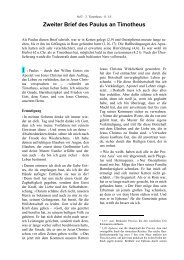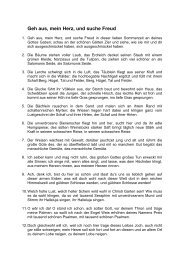Create successful ePaper yourself
Turn your PDF publications into a flip-book with our unique Google optimized e-Paper software.
Structure: The total amount of genetic information<br />
can be compared to a library, where single<br />
books represent chromosomes, and their chapters<br />
are the genes. Genes are like entries in a<br />
gigantic encyclopedia. There are 23 pairs of chromosomes<br />
in the nuclei of our somatic (body)<br />
cells, making up the diploid (Greek diplóos =<br />
double) number of 46 chromosomes. Single chromosomes<br />
can be distinguished according to their<br />
total length, the length of the chromosomal<br />
arms, and the position of the centromere, the<br />
point at which they are constricted. With the<br />
exception of the sex chromosomes, the chromosomes<br />
from each parent correspond to those<br />
from the other parent in regard to the type and<br />
sequence of the hereditary characteristics.<br />
Women have two equal sized sex chromosomes<br />
(XX), but men have a larger and a smaller sex<br />
chromosome (XY).<br />
The 23 human chromosome pairs comprise<br />
a double complement of approximately 100,000<br />
inherited characteristics or genes. Every gene<br />
occurs twice, one derived from the mother, and<br />
the other from the father; they are thus known<br />
as diploid chromosomes. In contrast to the body<br />
cells, the germ cells (egg and sperm cells) have<br />
a single complement of chromosomes, called haploid<br />
(Greek haplous = single). Since the 30,000<br />
genes are shared among 23 chromosomes, each<br />
chromosome is made up of about 1,300 genes.<br />
The DNA molecules of bacteria, when stretched<br />
out, are around one millimetre long. This corresponds<br />
to around 3 x 10 6 nucleotide pairs. The<br />
well known bacterium E. Coli has 7.3 x 10 6<br />
nucleotide pairs. In human body cells the total<br />
length of the DNA is around 2 metres, about<br />
6 x 10 9 nucleotide pairs.<br />
We must distinguish between the gametes or sex<br />
cells (which carry the information of heredity to<br />
the next generation) and the somatic or body<br />
cells. In the gametes (sperm and egg cells) the<br />
total length of the DNA threads is around 1 m,<br />
divided into 23 chromosomes. That represents<br />
3x 10 9 nucleotide pairs. These can constitute 10 9<br />
words (triplets, each of three chemical letters).<br />
The nucleotides are the four chemical letters of<br />
76<br />
the genetic alphabet, called Adenine, Guanine,<br />
Cytosine and Thymine. Human body cells carry<br />
a dual batch of hereditary information – one<br />
from the father and one from the mother. So<br />
they have 2 x 23 = 46 chromosomes, corresponding<br />
to a DNA length of 2 metres (6 x 10 9<br />
nucleotide pairs).<br />
The number of possible genes can be estimated.<br />
We start with an average sized gene product<br />
(protein), and look at the number of DNA building<br />
blocks (nucleotides) needed to code for that<br />
number of amino acids. For example, human<br />
hemoglobin, the pigment in red blood cells. The<br />
alpha chain has 141, the beta chain 146 amino<br />
acids. Each amino acid needs three nucleotides to<br />
code for it, so that means for both chains we<br />
need 3 x (141+146) = 861 nucleotide pairs.<br />
Therefore our DNA should theoretically be able to<br />
code for 3 x 10 9 /861 genes coding for proteins<br />
the size of hemoglobin. In reality, however, the<br />
majority of the DNA consists of sequences which<br />
do not code for proteins, and their function is<br />
still unclear today (though some hints may be<br />
gradually emerging). Only 50,000 to 100,000<br />
genes actually code for proteins. To put it another<br />
way: Only about three percent of the<br />
genome actually codes for proteins such as<br />
insulin or hemoglobin. Such program codes are<br />
identical for all people. Remarkably, in most<br />
instances, more than one gene codes for a given<br />
characteristic (e. g. eye colour).<br />
It seems necessary to assume that in addition to<br />
its protein coding portions, DNA contains countless<br />
additional levels of structure and function.<br />
Such stored information concepts are just as<br />
much required to code for the development of<br />
the smallest organelles such as the mitochondria<br />
and ribosomes, as for building the large <strong>organs</strong><br />
(e. g. heart, kidneys, brain) and the overall integrated<br />
organism. As yet, no one has been able to<br />
decode this incredibly complex system. Perhaps<br />
some light will be shed on this by research over<br />
the next few years.<br />
If the total paternal contribution to heredity is<br />
contained in a sperm cell, and the maternal in an<br />
egg, then this would have to not just involve the
















